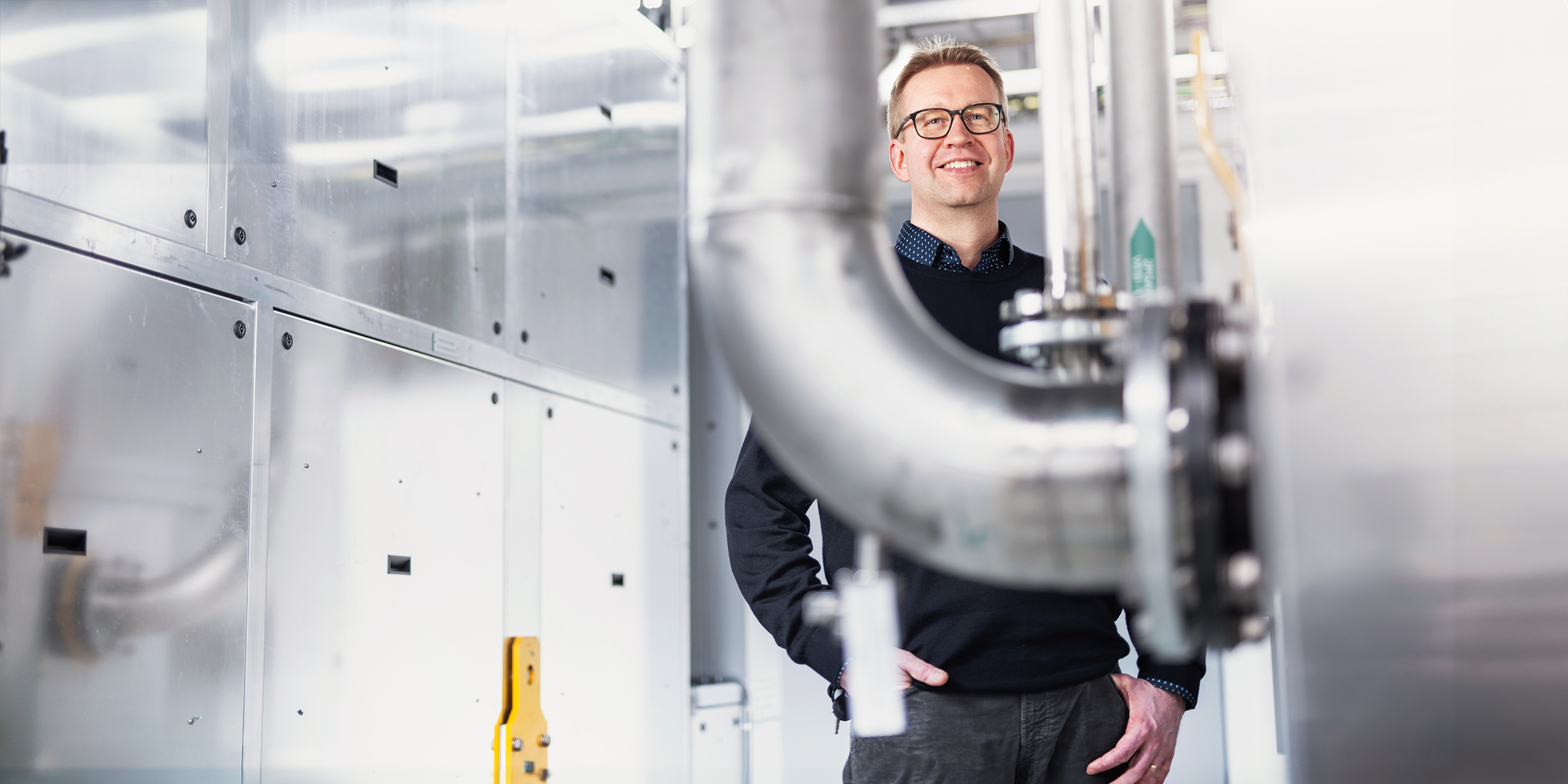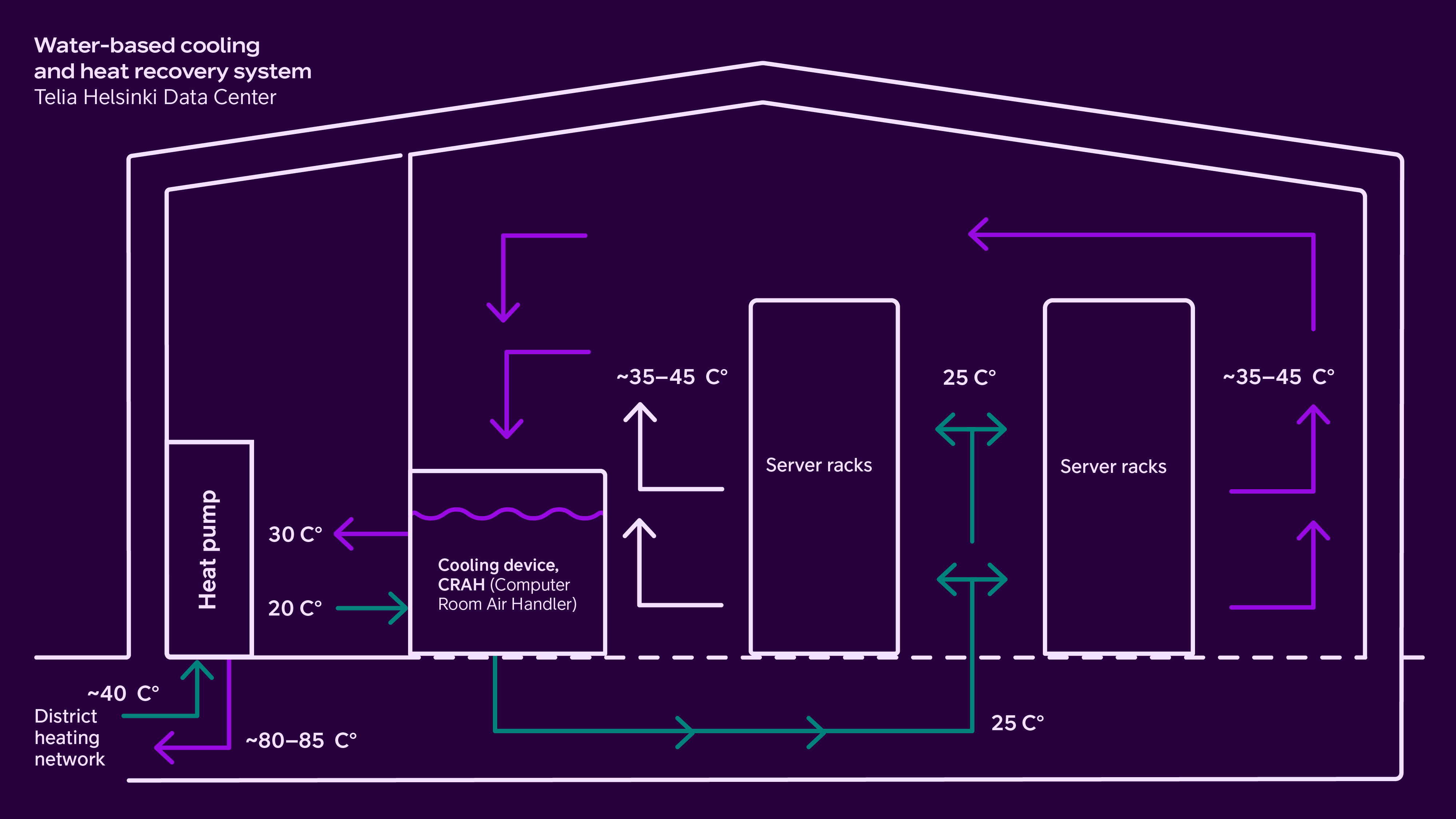We use cookies to personalise content & improve our services. By using our site, you consent to our Cookie Policy. Read more
Telia Helsinki Data Center serves as a radiator for thousands of homes


Telia’s Helsinki Data Center has been designed from the very beginning to be environmentally smart: the heat produced by the thousands of computers running inside the building is not pushed out to heat up the ambient. Instead, it is distributed to heat offices, homes and domestic water.
Any running electrical appliance always generates heat in its surroundings as well – that is why it feels warm near your computer or refrigerator. But when there are thousands of computers in the same building, so much heat is generated that the building and its machines would very quickly become unusable without cooling. Therefore, efficient cooling systems are needed in data centres.
Until 10–15 years ago, heat recovery in data centres was not a common goal. The Finnish climate was considered to be more important in the location of data centres.
“Finland is considered a good place for data centres because we have such a cold climate. The heat of data centres can be easily dissipated out and the temperature of the coolant kept sufficiently low. However, this kind of mere free cooling is not good for our environment, because it would mean blowing out our excess heat only to warm up our feathered friends on the roof, wasting valuable energy,” says Matti Tella, director of Telia Helsinki Data Center.
Telia Helsinki Data Center has been designed and built so that the heat it produces can be recovered and reused. The heat generated by computers is routed to heat homes and offices in Helsinki.
“The fact that technical possibilities and facilities of the heat recovery system were designed for Telia Helsinki Data Center before the actual construction was really pioneering, and now it is a real competitive advantage.”

About 60% of heat is already reused
Telia’s modern Helsinki Data Center, opened in 2018, is one of the ten largest commercial data centres in Europe. It offers super-secure and super-clean hosting space for both large international companies and small domestic businesses.
The heat collection system of Telia Helsinki Data Center was built in 2022–2023 together with the City of Helsinki’s energy company Helen, and it was commissioned in spring 2023. Telia was responsible for the facilities and electrical infrastructure of the pumping units. Helen had heat pumps and a district heating network connection built.
Heat collection has been quickly brought online, and after just a few months, as much as 60% of the heat produced by the data centre can be reused. The goal is to reach a level of around 80%.
In addition, the plant requires an actual cooling system to ensure reliability, but it can be operated at very low power while heat recovery is in progress. Significant savings can be achieved in electricity consumption, especially during the warm season when indoor air needs to be cooled and the outside air temperature does not allow for full free cooling.
The system relies on free cooling, as it is easy and inexpensive in Finland for most of the year, as well as mechanical cooling based on a compressor-operated water cooling machine.
However, the order of priority is clear: heat recovery comes first, free cooling is second, and mechanical cooling comes last.
Future heat for up to 20,000 homes
The heat collected from the data centre located in Pitäjänmäki is now transferred to Helen’s district heating network for distribution to around 7,000 offices or homes in Helsinki.
As the use of the data centre increases, there is more and more heat to distribute. Telia already has plans to expand the heat recovery system. In the near future, in the next few years, the data centre is estimated to heat more than 20,000 homes. At best, the city’s residents can take a warm shower more than 10 million times a year with the waste heat from Telia’s data centre.
A well-designed and implemented heat recovery and cooling system is significant both for Telia, which aims for net zero in 2040, and for its data centre customers. This system is important for the environment, and it is important also for economic reasons.
“Our customers are very interested in environmental aspects, as most aim for carbon neutrality or a significant reduction in carbon dioxide emissions in the next few years. International customers are also attracted to Finland by relatively inexpensive electricity and the stable conditions in our country.”
An ultra-clean data centre distributes its heat for reuse, while benefiting from recycling itself. Telia gets income from the recovery because Helen purchases the heat for its use. In addition, data centres that recover heat pay lower electricity taxes as a result of their good work. Due to the recovery, the facility’s actual cooling system is used less and with a lighter load. For Telia, this means monthly savings of tens of thousands of euros.
The reuse of waste heat also benefits Helen, which aims to be carbon neutral by 2030.
A building resilient to climate crises and floods
The location of Telia Helsinki Data Center in Pitäjänmäki, Helsinki, has also been carefully considered with safety in mind. The space has been calculated to withstand both the climate crisis and floods. The structures take into account both various security threats and the physical security regulations set by Traficom for telecom operator operations. Therefore, it can also serve customers with a very high security rating.
The data centre has about twenty computer halls on four floors, where companies can rent space for their servers. Each company rents as many racks as it wants, i.e., equipment cabinets in which to place their own equipment. Telia Helsinki Data Center covers an area of approximately four large football fields, i.e., 32,000 square metres. The facility can accommodate up to 200,000 servers.
Each hall consists of several cold/hot aisles insulated by their own doors, along which the equipment cabinets are located. The computers in the racks push out warm air, which is absorbed into a liquid-circulating heat recovery system.
“The heat recovery system recovers the heat collected by the coolant. To prevent the machines and the entire hall from heating up too much, some of the convection air is cooled by liquid circulation and returned cooled back to cool the air in the data centre," says Matti Tella.
This is how the cooling and heat recovery system works
- The water that acts as a coolant circulates in the computer room air handler (CRAH). The air passing through it cools down, and while circulating in the hall, cools the air in the hall. The heat generated by the computers is transferred to the circulating water.
- Three large heat pumps have been connected to the system and also to Helen’s district heating network. The cooling network and the district heating network are both closed circuits, which means that the same water does not circulate in both. Only heat is transferred between liquids.
- The heat pumps take in return water at about 30 degrees Celsius from the cooling cycle and transfer the heat to the circulating water of the district heating network. The temperature of the outgoing circulating water in the district heating network is approximately 80–85 degrees.
- The heat pump returns about 20-degree water to the data centre’s loop, used to cool the cooling air blown into the server halls.
- When heat recovery is operational, the actual cooling system of the data centre only operates at low power, relying on free cooling or water cooling machines. This also saves a significant amount of electricity.
